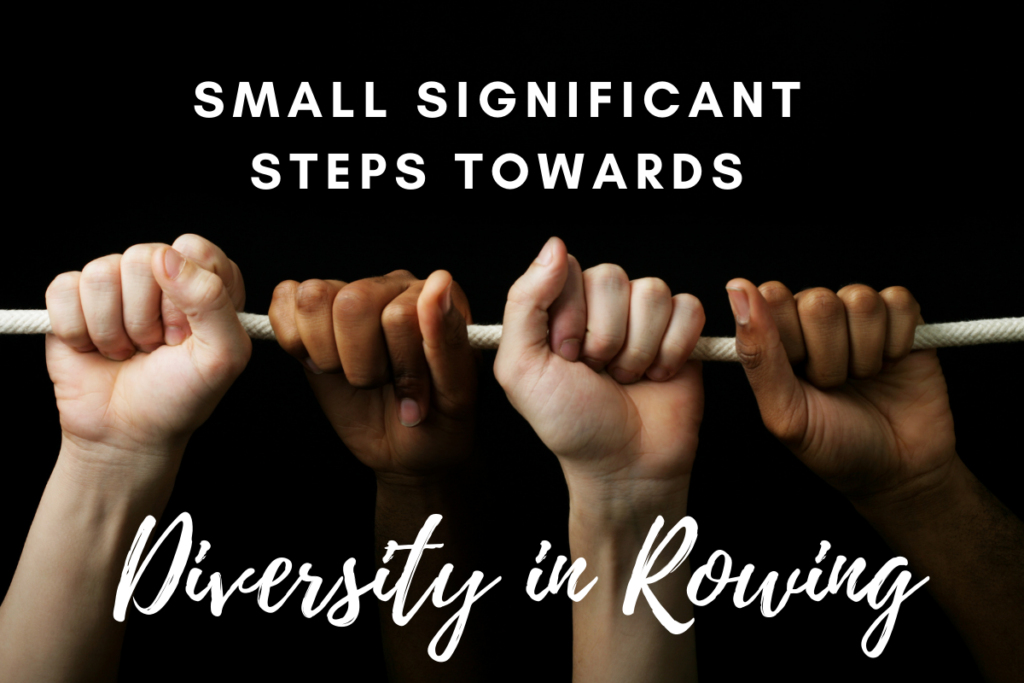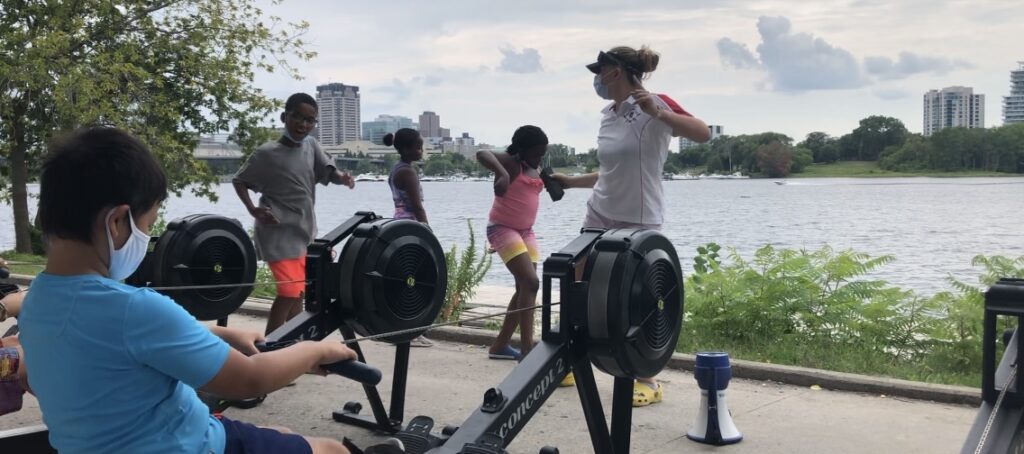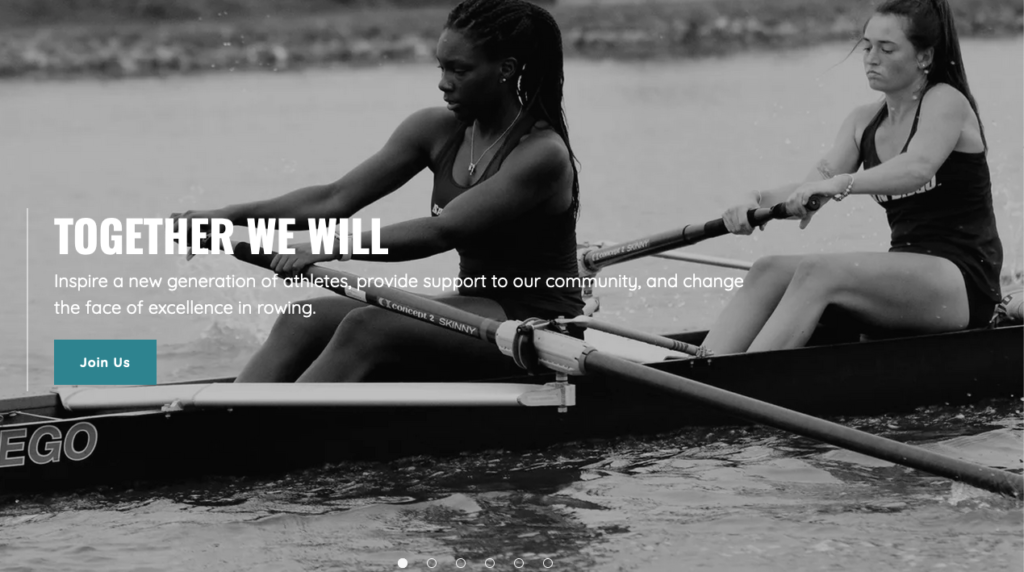
Small significant steps towards diversity in rowing
Arm raised in triumph. Smiles stretching across every face. A bottle of champagne about to be opened. I love this photo. This is what growing diversity in rowing looks like.

What I also love about this photo is what it does not show. I first saw it in a row2k article about A Most Beautiful Thing Inclusion Fund (AMBRIF) describing events, initiatives and successes which took place this past summer. The images in the article are about the athletes, the communities the clubs. Not visible is a representative from either Hudson Boat Works or Concept2. Together, these companies donated US$300,000 worth of equipment. AMBTIF distributed 10 Hudson doubles, 50 Concept2 ergs, and 60 Concept2 oars plus cash to five core program recipients.
Diversity in Rowing
We know that change is hard. It is especially hard when tackling large, systemic issues. It is even harder when other massive challenges clamour for our attention, like climate change and Covid 19. In 2020, in the midst of the pandemic, tragic murders caught the media and public attention, galvanizing the USA and other parts of the world to focus directly on racism. In Canada in 2021, the finding of unmarked graves at residential schools shocked the country.
Conversations and action began or continued, examining racism in many aspects of our lives and communities. Rowing more broadly confronted the reality that it remains a primarily white, elite and able-boded sport, even if some progress has been made for the inclusion of women.
Today, the rowing community continues to struggle to provide equitable access to the sport for ethnic and racial minorities, particularly the Black community, as well as athletes with disabilities and LGBTQ athletes.
Emily Spiegel in “The Ones We Leave Behind”
Talk is good. Action is better. Progress in diversity, inclusion and equity (DIE) in rowing was happening before the headlines focussed our attention. The Black high school crew from the rough west side of Chicago featured in the movie A Most Beautiful Thing had the remarkable opportunity to row in the late 1990’s. Witness established programs like Row New York, Delta Sculling Center and Fulham Reach Boat Club.
Row New York was founded in 2002, emphasizing the connection between the discipline of competitive rowing and rigorous academic support to empower New Yorkers of all backgrounds and abilities. “Where everyBODY sculls” is the motto of the Delta Sculling Center in Stockton California, with a long history of inclusive rowing programs including for veterans and people with disabilities. They are one of the five core programs of AMBTIF. Fulham Reach Boat Club in London England runs programs around its vision of rowing for all, working to reduce reoffending rates among serving prisoners and offering free summer rowing courses to community children most in need.
Everyone Plays a Role
Foundations, federations, clubs and individuals contribute to growing diversity in rowing. The George Pocock Rowing Foundation, created in 1984, is dedicated to helping kids of all communities find, start and stay rowing, and now also is a partner with AMBTIF. In 2020, the Head of the Charles Regatta of Boston and the Gold Cup of Philadelphia jointly awarded a total of US$100,000 in grants to seven US clubs to continue their commitment to diversity and inclusion in rowing.
Rowing federations have upped their game. In a year end interview, Amanda Kraus, the CEO of USRowing, recognized that it takes time for national teams to become more diverse. The work begins with a focus on young rowers at the club level. An excellent and current set of diversity, equity and inclusion resources are available on their website. Kraus announced a partnership between USRowing and STEM to Stern, an organization that reaches and supports populations which have limited access to rowing in communities across the USA. I see Concept2 is a corporate partner, along with JL Racing.
There is a very different STEM to Stern program in Canada, which will be featured in the 2022 Rowing Canada Aviron (RCA) virtual conference. The program engages marginalized youth to first build a wooden rowboat and then learn to use it. The construction projects expose the kids to science, technology, engineering and math, as well as gaining woodworking skills and learning teamwork. I see Hudson Boatworks is a partner.

It is Challenging Work
Diversity is a big topic at the RCA conference. One of the keynotes has the provocative title “Will diversity grow rowing in Canada?”. It recognizes that improving DIE in rowing is not simply about doing good or the right thing. We are all benefit. RCA has set ambitious targets to increase the number of rowers in Canada. In June 2020 RCA posted an impressive Statement and Action Plan – Racism and Inequality. I am sure that there are other things that I am not aware of, but I noted the plan to provide diversity grants to support travel to and participation in the conference before the pandemic forced it back online. I hope that the conference sessions will offer more examples and tools for clubs. Because it is hard work.
Many years ago, my rowing club ran a program that was not successful. When asked, our President shared some perspectives:
We did run a program for the Boys and Girls Club. The kids were primarily under privileged, but not ethnically diverse, as I recall. It was a disaster! Unknowingly we put the coach in situation that was way over her head. We didn’t provide anywhere near enough supervision and support to her and the group of kids trying a difficult and dangerous sport. I think we were trying to take advantage of some grant money and give the coach some work, but we did not think through or understand all that would be required to make it successful.
I have friends that have children that play hockey at the highest level for their age group. Due to Covid the expense isn’t as great as it normally is because travel and tournaments have been cancelled, but normally the annual expense is significant. In comparison rowing seems to be a cheaper sport to participate in, but it is still more expensive than sports like soccer and basketball.
There are many programs that provide opportunities to get kids from diverse backgrounds out on the ice to learn to skate and play hockey. Skating rinks can be found in every neighbourhood. That is of course, not the case for rowing. The fact that you can’t just row anywhere is a major barrier for the sport. Attracting high school students to a sport that is inconvenient in terms of timing of training and location is challenging in general. It is particularly challenging when families are not in a position to transport a kid to a rowing facility in the early morning hours. Diversifying rowing is going to continue to be difficult if some of the barriers are not broken down.

The knowledge, skills and support which we lacked then are more available now. For example, last year Ottawa Rowing Club worked with the Boys and Girls Club there and Athletes Combatting Racism to run a successful Everybody Can Row initiative.
It still takes a lot to get a program started. When asked about how we might improve diversity in rowing here in Manitoba, the provincial coach was supportive and willing. She pointed out that Manitoba Rowing Association is doing extremely well per capita in the 2SLGBTQ* area for our small population of athletes. She posed some good questions.
- Where do you start?
- What does the money come from?
- Will the target groups actually stick around?
- Where does the volunteer capacity come from?
- Is the club going to invest it in?
- Is the idea to introduce the sport to many? Those who can’t afford it? Organizations that deal with more kids or at risk kids? Just kids of colour?
- WHAT IS THE END GOAL OF RUNNING DIVERSITY PROGRAMS? To get them introduced to the sport, to get them to stay a lifelong rower, to get them to the Olympics? What is the focus and what is the goal?
She doesn’t have the answers to those questions yet. We need a champion.

What About Rowing Businesses?
The corporate world is also engaged, to varying degrees in DIE. Businesses, including those in the rowing industry, need to look inwards to their own hiring practices, Board membership and company policies. And outwards to diversity in rowing communities.
I am impressed by what I feel is the humility of Hudson Boat Works and Concept2 in their support of AMBTIF. When companies make significant donations, they often want recognition and profile. They want to be in the photograph. A Row New York post clearly stated “At this moment, it is particularly important to support and amplify the individuals and organizations leading this work.”. This is what these two companies are doing with their AMBTIF contribution and more.
Among other initiatives, Hudson is working with the Diversity and Inclusion Committee of Row Ontario to develop a similar program to the AMBTIF. Concept2 also supports the Black Coaches & Rowers Association. I am sure that there is more and will be more. Progress often takes place behind the headlines. I am guessing that there are other small significant steps being taken to improve inclusion, equity and diversity in rowing by these two companies and others. We need to hear these stories. They inspire us and they show us how it can be done. We need more celebratory photos.
Ruth, what a great piece. Clearly, much detailed research and analysis and your talented writing went into this. RCA has done a lot of good work, and we in the US can learn from their experience. Saving this in my resource list, and sharing out now!
Thank you so much Charlotte. I especially appreciate that from you. With your Ready Row! USA podcast you have been contributing so much too. https://readyrowusa.com/ And we can all learn from each other!
Ruth,
I am the Co-Chair for the USRowing DEI Committee, and I want to let you know that I appreciate the work that you doing. This is a great article and I will share it with our entire committee and USRowing. This article will definitely help spark even more authentic conversations, DEI strategies.
Respectfully,
Richard Butler
Richard,
Thank you very much. I am delighted that you found it helpful and I appreciate you sharing it. It would be terrific if it can spark more conversations. Happy to do my small part.
Best regards,
Ruth